Which is better for weight loss - rice or buckwheat: compare calories, benefits and reviews of those losing weight
Cereals are an essential component of any dietary and therapeutic nutrition, and their wide selection allows you to diversify your diet and organize a cereal diet for weight loss. Buckwheat, millet, pearl barley, oatmeal, rye, wheat, rice are sources of energy and components valuable for the body, each of these porridges is useful in its own way.
Among the wide range of cereal crops, buckwheat and rice are especially popular. From the article you will learn what is better for weight loss - rice or buckwheat, how many calories these cereals contain, what are the benefits and harms for the body, diet options and a sample menu.
Rice for weight loss
High nutritional value, taste, rich content carbohydrates and a modest amount of fat, ease of preparation and variety of dishes based on it make the rice diet one of the most popular all over the world. The benefit of cereal for weight loss is that it cleanses the body of waste and toxins, improves metabolic processes, reduces cholesterol levels, and neutralizes swelling.
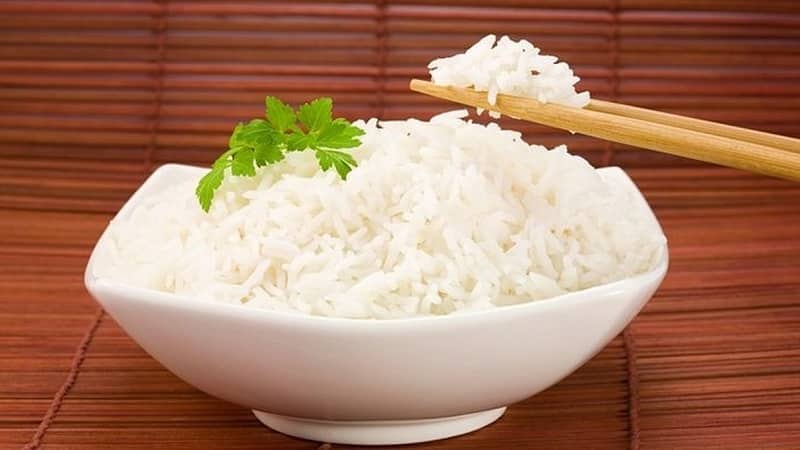
Not all rice is created equal. The nutritional, taste and dietary properties of cereals directly depend on the variety and method of grain processing. White polished rice is the most useless. It is suitable for preparing everyday dishes, but nothing more.During the grinding process, grains lose all useful components; the main substance remains starch, which has a high calorie content (350 kcal) and a glycemic index (over 80 units).
Nutritionists It is recommended to eat brown unpolished rice, as an alternative - steamed white rice cereal. All positive characteristics of the product remain available due to the preservation of the bran shell. It contains the largest amount of nutrients and substances beneficial to the human body.
Calorie content and BZHU
Energy value of a serving (100 g) of brown rice in dry form is 367 kcal. After cooking, the calorie content is reduced by almost 2 times and reaches 112 kcal. Dry cereal is rich in carbohydrates (72.7 g) and low in proteins (7.5 g) and fats (3.2 g).
Beneficial properties, possible harm
Cooked brown rice is very filling for your body.. After a rice dish, there is no feeling of hunger or need for snacks for several hours. Cereals have a rich carbohydrate composition, where most of the macronutrients are absorbed gradually, which fills a person with energy for a long time, increases endurance and performance.
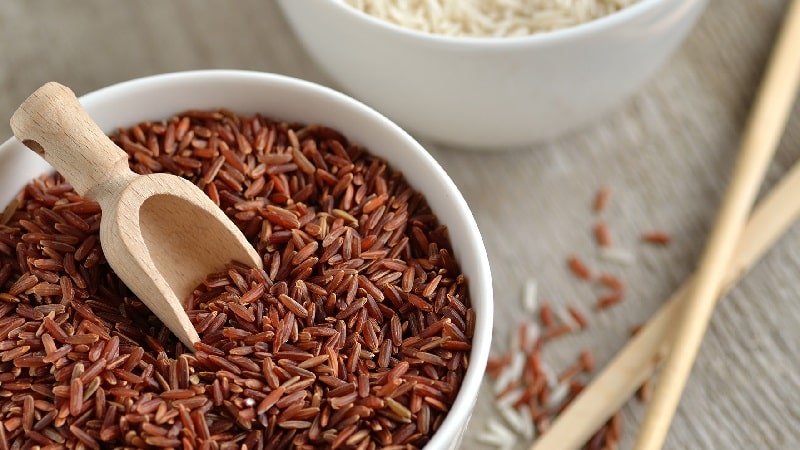
At the same time, physical activity promotes additional calorie burning. Due to the presence of plant fiber in the composition, which accelerates the process of fat breakdown, carbohydrates do not turn into fat reserves.
Fiber also has a positive effect on intestinal peristalsis, removes waste and toxins from the body, lowers blood sugar levels, helps eliminate cholesterol plaques.Dietary fiber is characterized by adsorbing properties, due to which it has an anti-inflammatory effect on the intestines.
Brown rice contains a lot of protein, necessary to maintain muscle tone and the normal functioning of the body’s cellular system. Proteins are involved in the metabolism of fats, minerals, carbohydrates, and vitamins.
For reference. It is recommended to include rice dishes in the diet of people with gastrointestinal diseases of an erosive and ulcerative nature. Cereal reduces acidity levels, coats irritated mucous membranes, protects against the destructive effects of aggressive radicals, and reduces pain.
Due to its pronounced diuretic effect consumption of cereals has a positive effect on the functioning of the kidneys and other organs of the urinary system, which is manifested by the removal of excess fluid from the body and getting rid of edema.
Brown rice prevents diseases of the cardiovascular system, in particular atherosclerosis, cardiac ischemia, myocardial infarction. It strengthens and increases the elasticity of the walls of blood vessels and small capillaries, normalizes blood circulation processes, eliminates harmful deposits, and reduces cholesterol levels. Due to the ability to stabilize high blood pressure, it can counteract developing hypertension.
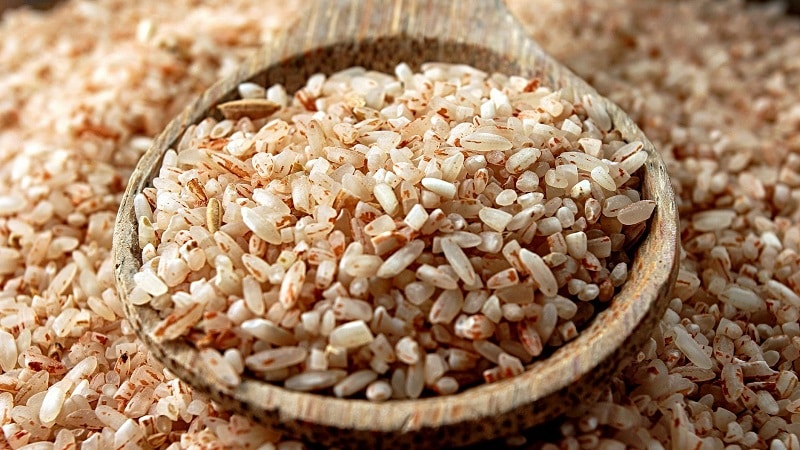
The product in moderate quantities normalizes blood glucose levels, which is especially important for diabetes. The rice diet alleviates the condition of people suffering from osteochondrosis, rheumatism, gout, and arthritis. The cereal has an anti-inflammatory and analgesic effect, regulates the metabolism of purines in the body, and removes crystals of uric acid salts.
Calcium in rice necessary for the mineralization of teeth, maintains bone strength, provides muscle contractions, blood clotting processes and nerve impulse transmission.
Rice helps with diarrhea, however, its excessive consumption can provoke the opposite condition - constipation. Other negative properties of brown rice include the content of a harmful substance in the pityriasis shell - phytic acid. In excess quantities, it inhibits cell development, impairs the bioavailability of phosphorus, magnesium, calcium, and other mineral salts, and corrodes bone tissue from the inside in osteoporosis.
About other ways to lose weight:
Cooking and drinking pumpkin juice for weight loss
Buckwheat for weight loss
Buckwheat diet is a simple, inexpensive and effective way to get rid of extra centimeters on the waist.. The effectiveness of weight loss is achieved due to the absence of “fast carbohydrates” in the composition.
The fiber in the composition does a good job of cleansing the intestines of toxins; the body spends more calories on its processing than it consumes. A significant advantage of buckwheat is the absence of gluten, which can cause allergic reactions.
Calorie content and BZHU
The calorie content of dry fried buckwheat is 346 kcal, when cooked it is 101 kcal.
100 g of dry cereal contains:
- proteins - 11.7 g;
- fats - 2.7 g;
- carbohydrates - 64.7 g.
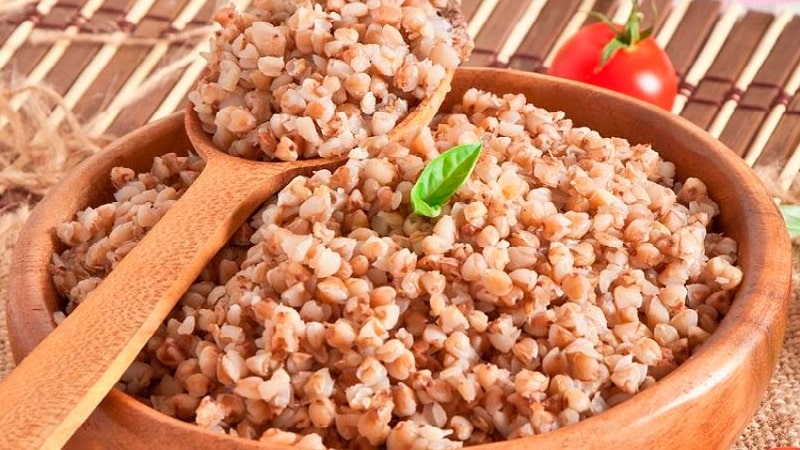
Beneficial properties, possible harm
Foremost beneficial effect of buckwheat - cleansing the digestive system of waste and toxins, which helps reduce cholesterol and blood sugar levels.Cereals facilitate bowel movements during constipation, soften stools, and stimulate bowel movements.
Buckwheat has a high content of flavonoids. They have anti-inflammatory, bactericidal, antioxidant properties. They help strengthen blood vessels, increase their strength and elasticity, have a beneficial effect on the functioning of the thyroid gland and heart muscle, and prevent the formation of tumors and the spread of cancer cells.
Including buckwheat in your diet prevents the occurrence or exacerbation of arthritis, varicose veins, supports the functionality of the adrenal glands, regulates the activity of the central nervous system, and has a beneficial effect on the condition of the skin, hair, and nails.
Buckwheat provides the human body with B vitamins, because of which cereals are so valued. Riboflavin (vitamin B2) promotes oxygen saturation of the blood, choline (vitamin B4) is responsible for neuromuscular transmission, stimulates thinking processes, has a positive effect on brain activity, and improves memory. Folates (vitamin B9) promote better absorption of iron in the body, affect mood, appetite, and the state of the nervous system.
Buckwheat dishes are recommended to be consumed athletes, people engaged in heavy mental, physical, emotional labor, as cereal accelerates recovery processes and saturates the body with useful components. Copper increases the body's resistance to aggressive external and internal factors, enhances water, mineral and gas metabolism.
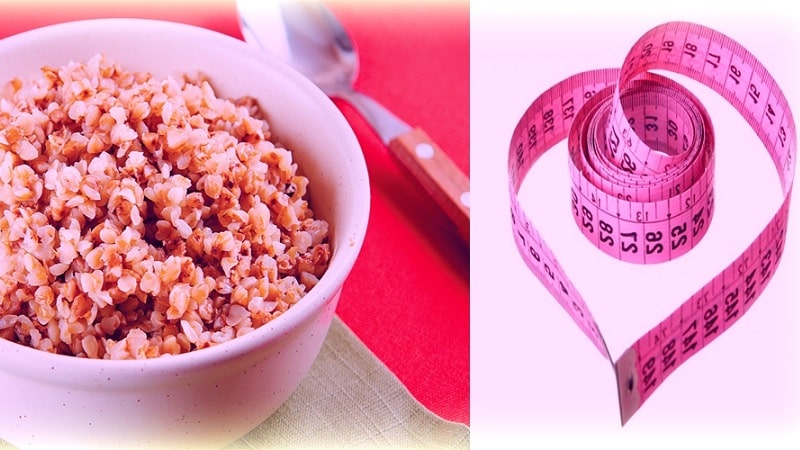
Selenium is a powerful antioxidant that has a positive effect on cardiovascular system, improves blood flow to the heart, neutralizes harmful substances in the liver.Its consumption prevents a decrease in bone density with deformities of the limbs and even the spine (Kashin-Beck disease). Zinc is necessary for the formation of bone and cartilage tissue, slows down the development of cancer cells, and improves the absorption of B vitamins.
Eating buckwheat provides the body with phosphorus., which plays an important role in metabolic processes, regulates acid-base balance, and is necessary for the skeletal system for complete mineralization.
Positive properties of buckwheat outweigh the negative side effects, but they still exist. A long-term diet on buckwheat can lead to exacerbation of chronic diseases, cause digestive problems, headaches, weakness, dizziness due to glucose deficiency.
What is better for losing weight: buckwheat or rice?
There is no clear answer to the question. When choosing a dietary menu, you should focus on gastronomic preferences and the presence of possible contraindications, concomitant diseases and pathological conditions.
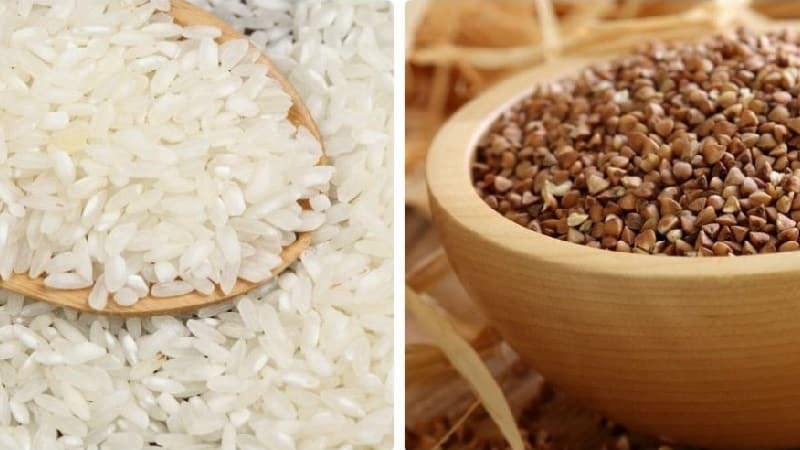
If a person who wants to lose weight suffers from swelling, then it is advisable to give preference to rice cereals. It has a diuretic effect, removes excess water from the body, due to which swelling goes away.
Buckwheat will be more beneficial for people with low hemoglobin levels. Therefore, the question of which diet to choose for weight loss - rice or buckwheat - must be considered separately in each specific case.
Which is healthier?
If you compare rice and buckwheat, they have similar nutritional and dietary properties.Both grain crops act as sources of energy, substances beneficial to the body, cleanse the intestines, normalize metabolic processes, promote weight loss, and improve the condition and functionality of the digestive, nervous, urinary, and endocrine systems.
All diet options are highly effective, but each has certain benefits.
Read also:
Arguments in favor of buckwheat
Nutritionists value buckwheat for its high iron content., sufficient intake of which serves as a good prevention of the occurrence of iron deficiency anemia. Buckwheat does not contain starch, which can cause constipation if consumed frequently.
Buckwheat is superior to rice in the number of protein compounds, which makes it ideal for weight loss. Proteins serve as the main material for building cells, tissues, organs, and participate in metabolic processes.
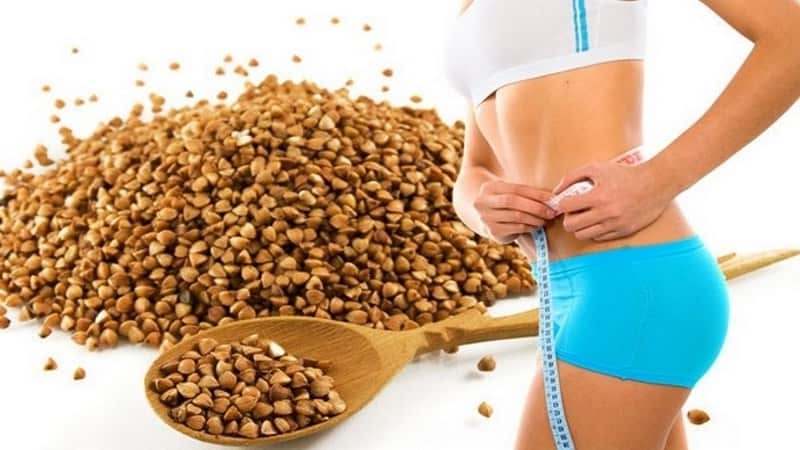
Nutritionists recommend choosing buckwheat for weight loss, if additional physical activity is present. The cereal contains rutin and quercetin, which improve blood circulation, reduce capillary permeability, and ensure the conductive work of the heart, which is extremely important, since motor actions increase the load on the heart.
Arguments in favor of rice
Rice compares favorably with other grains, including buckwheat, with adsorbing properties. Grains contain starch, which cleanses and absorbs waste and toxins inside the intestines. Rice protects the surface of the mucous membrane of the digestive canal from the influence of pathogenic microflora, aggressive mechanical and chemical influences.
Rice is a source of complex carbohydrates, so the body will not experience energy deficiency. The rice diet is quite filling, and there are practically no hunger pangs. Due to the absence of gluten, this dietary regimen can be followed by people with celiac disease.

How to cook better when losing weight and in what form to eat
Weight loss results depend not only on the right choice of cereal variety, but also from proper heat treatment. Porridges are prepared fresh, without salt and sugar. It is acceptable to season with lemon juice, natural vegetable oil or soy sauce.
Rice
It is recommended to cook rice for diet by steaming or boiling, sometimes with pre-soaking. Rice can be used to prepare not only a side dish, but also lean rice meatballs, soup, and casserole.
For reference. White unpolished rice cooks quickly, boils well and remains fluffy, brown rice takes longer to cook (about 30 minutes), has a specific taste and moderate hardness.
Buckwheat
In order to preserve the nutritional, beneficial and dietary properties of the cereal nutritionists advise losing weight not on boiled buckwheat, but on the grain, steamed in boiling water and infused until tender. As an alternative, buckwheat is steamed and simmered in the oven.
Rice diet: options, how much, and over what period you can lose it
There are many varieties of rice diets, which can be divided into mono-diets and combined ones. To maintain a certain weight or bounce back after overeating, a fasting day on rice is ideal. Unloading lasts 1-2 days, during which time you can reduce body weight by 1-1.5 kg by cleansing the intestines of waste and toxins and removing excess water from the body.
Rice diet for 3 days is presented in two options. The first involves a strict menu restriction: only rice without salt and sugar, water and herbal tea. This regimen can reduce body weight by 3-4 kg, cleanse the intestines, but can disrupt metabolism and cause health problems. The second modification of the rice diet is characterized by a complete diet, expanded with vegetables and fruits. The weight in 3 days is 2-3 kg.
Tough, but less harmful to the body, rice diet for 5 days. This dietary regimen allows only 2 meals, one of which is a portion of boiled rice, and the second is a choice of fresh fruits, vegetables, herbs, lean fish or meat. With strict adherence to the diet, the diet promises a weight of 3-5 kg. A pleasant bonus will be a feeling of lightness in the stomach and improved skin condition.
The simplest and most affordable rice diet lasting 7 and 9 days. The essence of the regime is to eat boiled rice three times a day without salt and sugar, supplemented with fresh fruits, vegetables, lean fish and meat. Average weight loss rates are 4-8 kg in 7 days, 6-7 kg in 9 days. If you add physical activity, the effectiveness of weight loss will increase and reach up to 10 kg.
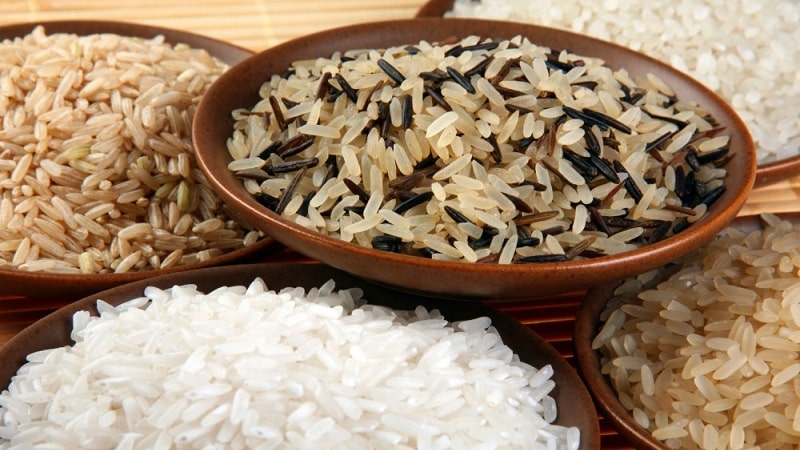
Sample menu
Rice diet for 3 days consists of 250 g of cereal, boiled until softened with preliminary soaking overnight. Prepared rice is divided into small portions and consumed throughout the day with other permitted foods.
Day 1
- Breakfast: a portion of rice, an apple baked with cottage cheese and dried apricots.
- Lunch: a portion of rice, vegetable broth, fresh cucumber and cabbage salad, seasoned with vegetable oil.
- Dinner: a portion of rice with stewed carrots, boiled hake, sea buckthorn tea.
Day 2
- Breakfast: a portion of rice, a small orange.
- Lunch: a portion of rice, vegetable soup, applesauce with lemon zest.
- Dinner: a portion of rice, steamed vegetables.
Day 3
- Breakfast: a portion of rice, grapefruit.
- Lunch: a portion of rice, low-fat broth, boiled beet salad with 1 tsp. vegetable oil.
- Dinner: a portion of rice with dried apricots and prunes, green tea.
Throughout the weight loss process, train yourself to drink more purified water., as it prevents the strengthening effect of the rice. For constipation, herbal decoctions with a laxative effect help well.
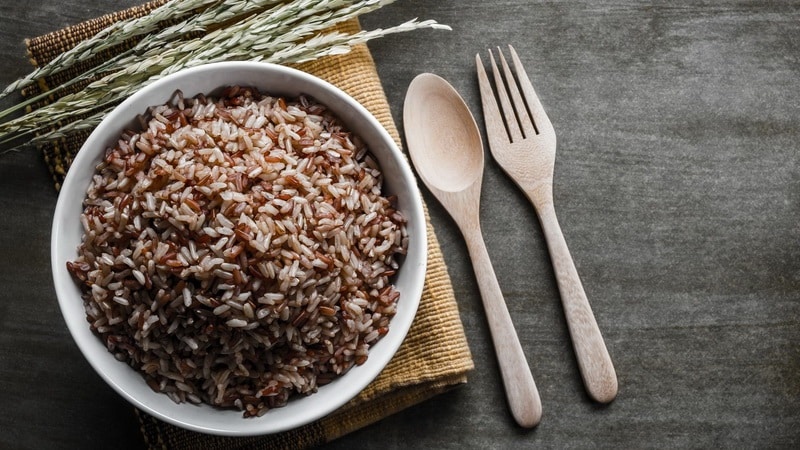
Buckwheat diet: what are they and how much can you lose?
Depending on the desired weight loss result, buckwheat is eaten for 1, 3, 5, 7 and 14 days, allowing for the consumption of only steamed buckwheat and liquid or a nutritious diet with a limitation of harmful foods.
If within 1-5 days you can do without protein foods of animal origin, then a dietary regimen designed for a longer period of time involves the consumption of low-fat varieties of fish, meat, eggs, which contributes to a balanced supply of nutrients to the body.
A monotonous diet can harm the body. The most useful and effective will be combination diets, which not only help you get rid of extra pounds, but also enrich the body with minerals and vitamins.
The result of losing weight depends on your diet, severity and duration of the diet, initial weight indicators. People whose weight is not far from the norm find it harder to lose extra pounds. Obese people can lose up to 10 kg in 2 weeks of a light version of the buckwheat diet. On average, the weight of a three-day mono-diet varies between 2-3 kg. A five-day diet can get rid of 3-4 kg of excess weight, a week - from 5-6 kg.

Sample menu
The menu for day 1 of the mono-diet is limited to only steamed buckwheat or in combination with kefir, apples.
Combination menu for 1 day of a two-week diet might look like this:
- Breakfast: a portion of steamed buckwheat porridge, one small apple.
- Second breakfast: a portion of steamed buckwheat porridge, a salad of fresh vegetables (cabbage, beets, carrots).
- Lunch: a portion of steamed buckwheat porridge, vegetable broth, boiled broccoli, a glass of orange juice.
- Afternoon snack: a portion of steamed buckwheat porridge with dried fruits.
- Dinner: kefir.
Reviews of those losing weight
Many have tried to lose weight on rice and buckwheat. In some cases, those losing weight leave positive reviews that the weight really goes away, and if the principles of proper nutrition are followed, it no longer comes back. There are also those for whom the diet did not bring any results, except disappointment and health problems.
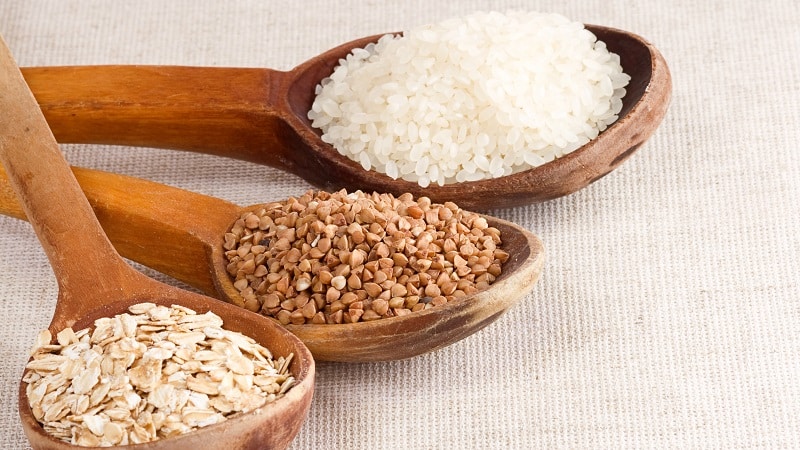
Marina Kalyakina, 50 years old: “When I broke my leg and had to limit my mobility, I gained 8 kg in 5 months. My daughter recommended trying a two-week rice diet. This was my salvation. In 5 days I lost 2 kg, at the end of the diet the weight was minus 7 kg. I feel great, I have no problems with my intestines, no headaches.”.
Kira Safronova, 38 years old: “After a course of hormone therapy, I gained extra pounds. I began to look for the best diet option for myself. Since I am a big fan of buckwheat porridge, I decided to stick to the buckwheat diet. Buckwheat fills you up well, and you don’t feel hungry for a long time, but it’s hard to eat it every day, it becomes tasteless, although it’s effective. My result in 10 days was minus 5 kg.”.
Conclusion
Rice and buckwheat are ideal foods for weight loss.With proper organization of the dietary regimen, cereals free the intestines from accumulated toxins, normalize water-salt metabolism, lower the amount of sugar in the blood, and have a positive effect on overall health. After all, normal immunity is necessary to activate the process of cleansing and weight loss.
Before losing weight, pay attention to the presence of contraindications. These include: pregnancy and breastfeeding, serious heart and vascular diseases, pathologies of the endocrine gland, anemia, infectious diseases, diabetes mellitus, mental disorders, childhood and old age.